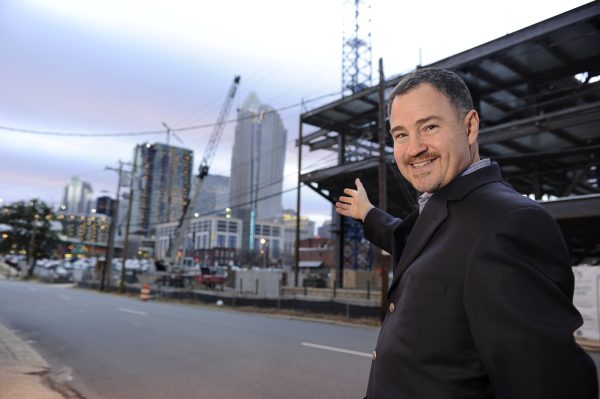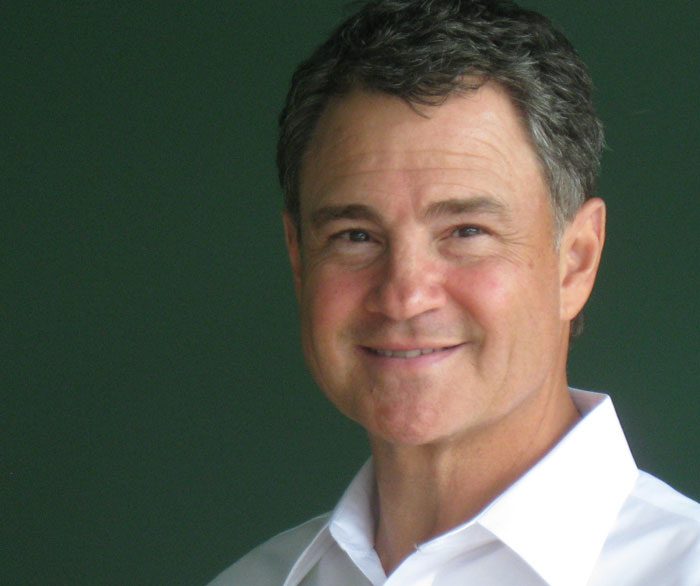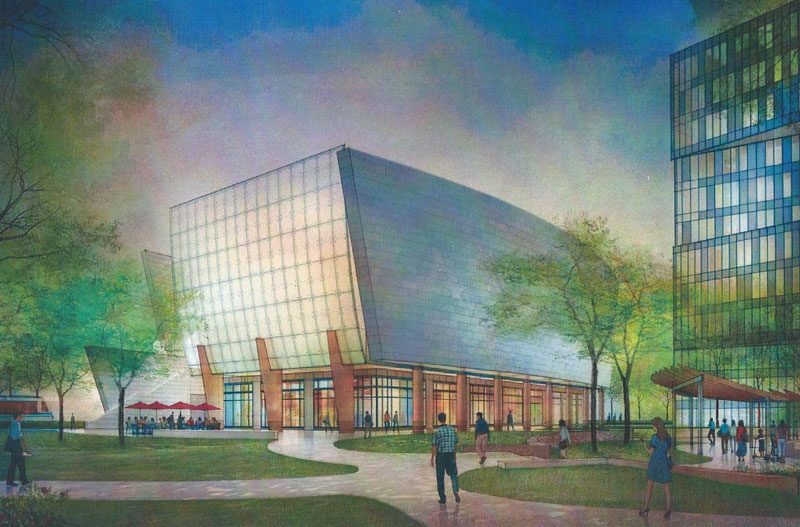Developer Daniel Levine: I’d rather do nothing than not do it well

Developer Daniel Levine – who with his father, Al Levine, and uncle Leon Levine together own some 23 acres of prime First Ward Property – has become a key player for the future of uptown development. Until now, he hasn’t developed much, keeping the land as parking lots. But that’s changing. Levine has partnered with the City of Charlotte and Mecklenburg County to build a public park and two parking decks, in exchange for $23.7 million in city/county economic development money, to be paid after the decks and park are built.
Monday the Charlotte City Council unanimously approved changing its former agreement with Levine, which had called for building underground parking beneath the park. Under the new agreement the 1,300 parking spaces will be in two above-ground decks.
The park, an apartment building and another deck with retail on the ground floor and offices above the parking are all part of plans Levine has had for years. He hopes, he says, to turn his property into a true urban neighborhood.
Levine talked recently with PlanCharlotte.org director Mary Newsom about the land acquisition, his plans for development and why he hasn’t, until now, launched those plans. His remarks, edited for clarity:
|
• Read news coverage of Monday’s council vote. • Click here to download a PDF from the city of Charlotte of the original parking deck plan and the revised plan the council approved. |
Q. Levine Properties is your company – do you have partners or co-investors?
A. I went to college the year my father [Al Levine] sold his business, Pic ’n Pay Shoes. He retired the year I graduated and came back to Charlotte. I started Levine Properties, and he has been my partner from Day One. It has been a great partnership.
He’s always been of the business, never in the business. I look back now, at 51, and say, “Oh God, how trusting he must have been to allow me to make all the mistakes you could make at the age of 22.”
Q. What kinds of things has your company developed?
A. We built a lot of business parks, which include retail, industrial, office, office showrooms. We do build-to-suit work, FedEx around the country. We do a little multifamily now. After college, I never worked for anybody else.
We don’t sell. My father comes from the old school, where you build a good quality product, you lease it up, you take care of your customers, and the rest will take care of itself. You don’t over-leverage, you pay down your debt, and the rest takes care of itself. Over 29 years, he’s been right.
There are cycles. Sometimes office is in and retail is out, and we’ve been busy all the way through. We did get lucky. I wish I could tell you it was divine intervention or smarts, but we sold a handful of properties in the spring of 2008. The door was shutting on our be-hind as the economy went pshhhhhhouuu. We were really fortunate to come through this downturn in good shape.
Q. Your strategy has been to buy land and put parking on it. Do you run the parking company?
A. Secure Parking is a separate company that we operate.
Q. What’s the best development you’ve seen, in Charlotte or elsewhere?
 A. For an idea of what I hope to accomplish in First Ward, I would say one of my favorite developments is Country Club Plaza in Kansas City built by J.C. Nichols in the 1920s. It was one of the first suburban shopping centers. Over the last 75-85 years, it has been able to change with the times. It’s a wonderful place to be in. It’s got houses, hotels, retail, great art. It’s got it all, and it’s just wonderful.
A. For an idea of what I hope to accomplish in First Ward, I would say one of my favorite developments is Country Club Plaza in Kansas City built by J.C. Nichols in the 1920s. It was one of the first suburban shopping centers. Over the last 75-85 years, it has been able to change with the times. It’s a wonderful place to be in. It’s got houses, hotels, retail, great art. It’s got it all, and it’s just wonderful.
What I like about Country Club Plaza is not the bricks and the mortar, but that over those years it has become the place in Kansas City where people go to celebrate life’s moments. Where are you going to celebrate your birthday, your anniversary, your graduation? You’re going to the Plaza. My mother is from Kansas City, and I’ve wondered over the years as I’ve traveled there, thinking about Charlotte: Where’s our place?
Q. Are you saying you have a vision that what J.C. Nichols did for Kansas City, you can maybe do for Charlotte?
A. I try not to be an arrogant, pompous person, but one has to have a dream. Our dream, my father’s and my uncle Leon’s, is that we can help put the structure in place so that over the next 100 years, potentially, this site could become a place with soul. We’re not going to give it soul. It will be the people who come and put their blood, sweat and tears, and soul into it who will make it become something.
I will tell you one thing. If it becomes a Disneyland Main Street it will have become something I hoped it wouldn’t be. It needs personality and real character.
Q. What was in your mind when you first started buying property in First Ward?
A. The first building we bought back in 1981 was what we converted into 119 E. Seventh St. My mother was involved. One of her friends convinced her to buy the building. My father agreed.
I had gotten an interdisciplinary degree from Chapel Hill in business and city and regional planning, and studied what the banks [NCNB, now Bank of America] and Mr. [Hugh] McColl and Dennis Rash [one of McColl’s executives] were doing in Fourth Ward. So I was familiar with what was going on uptown. I noticed that all the land north of Seventh Street traded at a 40 percent discount to everything south of Seventh Street. I wondered why. So I went down to the tax department and spent weeks piecing together a nine-square-block area, digging into who owned what.
I went to my father and said wouldn’t it be great to own nine square blocks? He laughed me right out of his office. But, I said, I think this area of the city can be something.
So the first purchase was the Brown, Rogers, Dixson Building [a warehouse on East Seventh Street near ImaginOn, demolished in 2001]. My father helped me buy it. In the last 27 years I’ve bought everything in that original plan with the exception of three parcels – 60 or 70 different transactions. Over those years I thought I was going to be one of two things; either I was going to be the dumbest guy in the city, or a guy that had a little bit of vision, because nobody else was buying in this area. I’m buying, I’m buying, nobody else is buying!
Q. You’ve acquired the land and held it. Talk about the company’s strategy in that.
A. Originally, it was just an investment. You buy something at a discount, hold it, let it mature, sell it for a profit, do it again. But something happened along the way. It’s hard to explain.
From about ’86 on, as we bought property, I thought, “We ought to do this with it, and then as soon as I thought that, something significant would happen here, mostly between Mr. McColl and Mr. [Ed] Crutchfield. [McColl became CEO of Bank of America; Crutchfield of First Union, now owned by Wells Fargo.] Every time something would occur, I would think that I wasn’t thinking broadly enough. What I thought could happen was always trumped.
By 1999 we had about 11 acres. The city and the county said they wanted to cause something significant to happen on the north side of the city. They put out this big RFP [request for proposals] for their Hal Marshall Center property and the old city bus barn behind it. I convinced our team to partner with Cousins Properties, who was doing Gateway Village, to answer the RFP. I thought it could be fantastic. Putting the city and county property together, about 17 acres, along with our 11 – almost 30 acres – you could almost build a neighborhood!
|
Read more Q/A interviews • Anthony Foxx, Charlotte mayor • Mitchell Silver, president of American Planning Association |
I got enamored with the idea of a neighborhood. I felt like this was not just a business opportunity but a significant responsibility. I made sure all my i’s were dotted, my t’s were crossed, etc. One of the things I’ve lived by is that I’d rather do nothing than to not do it well.
I was young and still somewhat naïve. The city and county selected the Related Companies. I was just slackjawed, to be honest with you. What I couldn’t believe, even to this day to be honest with you: How could they pick the Related Companies when half their plan was on my property, and I made it very clear, we’re not selling our property? Ultimately the Related Companies did not move forward.
My idea of what this could become was ever-evolving, because our city was growing so fast. I wanted to make sure that we were aiming appropriately high enough.
When I heard UNC Charlotte was looking to build an uptown campus, I went to the chancellor and said, look, here’s what we’re hoping to accomplish, pick any piece of property we have. We can’t give it to you, but we’ll discount it.
Q. You haven’t yet broken ground. What have been the issues that might have slowed the launch?
A. The heart of this plan has not changed significantly since 2000. When we were rejected by the city and the county, we went on to buy the old bus barn on 11th Street. We said the heart of this neighborhood is going to be a major urban park. We were convinced every great urban neighborhood needs great open space.
For years we lobbied the city and the county to assist us to make that one item happen. It took 10 years, but finally in January 2010, we got approved in a pretty major public-private venture to make this park and the infrastructure around the park occur, and to put parking under the park to serve the UNC Charlotte building and the neighborhood.
Unfortunately, the harsh reality of the economy made it impossible to get financing. The banks said, not just, “No” – “Hell, no!” So, though I will probably live to regret not having the parking under the park, it’s more important to get started.
We asked the city and the county last year to amend our agreement and let us exchange underground parking for above-ground parking. [The City Council on Monday agreed to revise the agreement.] It will go in front of the county commissioners in October. We can move forward with the first phase. Nothing was going to happen in this neighborhood until there was certainty around what was going to happen all around.
There is great responsibility to this community in our hands. It just has to be done right.
Q. Do you build the park, or is the city or the county building it?
A. We will build the park, execute the city infrastructure, build all the private streets, build 10th Street, which will be a new, public street, and then donate it to the city. When we’re complete with the park and the infrastructure, they’ll reimburse us for the park and the infrastructure.
The simple math is that the underground deck would have cost about $43,000 per space. It was designed in better times. We asked, instead, to build a 1,370-car deck. For UNC Charlotte, we’ll deliver all their 305 spaces in one shot, and we’ll build a little mews from the front of the building all the way down the street to the parking deck.
My understanding is that one building does not make a campus, so when North Carolina is able to re-emerge financially strong, and the campus systems are able to grow, there’s a possibility UNC Charlotte might want a second building. We’ve identified half of a block, fronting on Brevard Street, for that growth. We’ve identified the other half as a second phase of a park, up against the light rail line.
The first phase of this project is the public park, an $11.5 million-dollar investment. The public infrastructure is approximately $5.5 million of investment. This parking deck is about $24 million. The apartments are approximately $23 million.
We’re also going to build the base for what will become a 20-story office building. It will have retail on the ground floor and 350 parking spaces above it. We’ll go up five stories of parking, so when we build the office, we’ll build right on top. This is going to be a fantastic building. You can’t just put a parking garage with strip fluorescent lighting blaring out onto this public park. So we spent a great amount of time designing a parking garage that doesn’t look like a parking garage. It looks like, dare I say, a museum.
I don’t know if you’ve seen the Disney Concert Hall in Los Angeles. They use the most beautiful product I’ve ever seen, crystallized titanium. It is spectacular. That’s what we’re going to use to cover this building.
Q. When do you actually put your shovel in the dirt?
A. Sometime in December. The agreement says I have to before Dec. 31. But the biggest part of the job will happen after Jan. 1.
Q. What happens if something unforeseen happens with the financing?
A. Like if Europe blew up? It could happen. So if there’s a major catastrophe, or another recession, then we’re out of luck. This public-private agreement will expire Dec. 31 if we do not get started.
Q. Tell me a little about your background.
A. I was born in Charlotte and grew up right around the Cotswold area. I went to Rama Road Elementary, McClintock and East Meck. I also went to Piedmont Middle School in eighth- and ninth-grade – the first two years of Piedmont’s open school format.
That’s where my love of the city emerged. I took the city bus to The Square, transferred to 10th Street every day. The bus picked me up off Randolph Road, right at the bottom of my street. I was 14.
Another big influence was Walt Disney. I was 7, 8 or 9 – I can’t remember exactly – but I was in my dad’s office and a Fortune or Forbes was lying around, so I read Walt Disney’s dream of what Epcot was supposed to be. It was like a lightning bolt. Wow, you can build a new city from the ground up and plan everything for the betterment of everybody – where they can live, work and play. How cool is that?